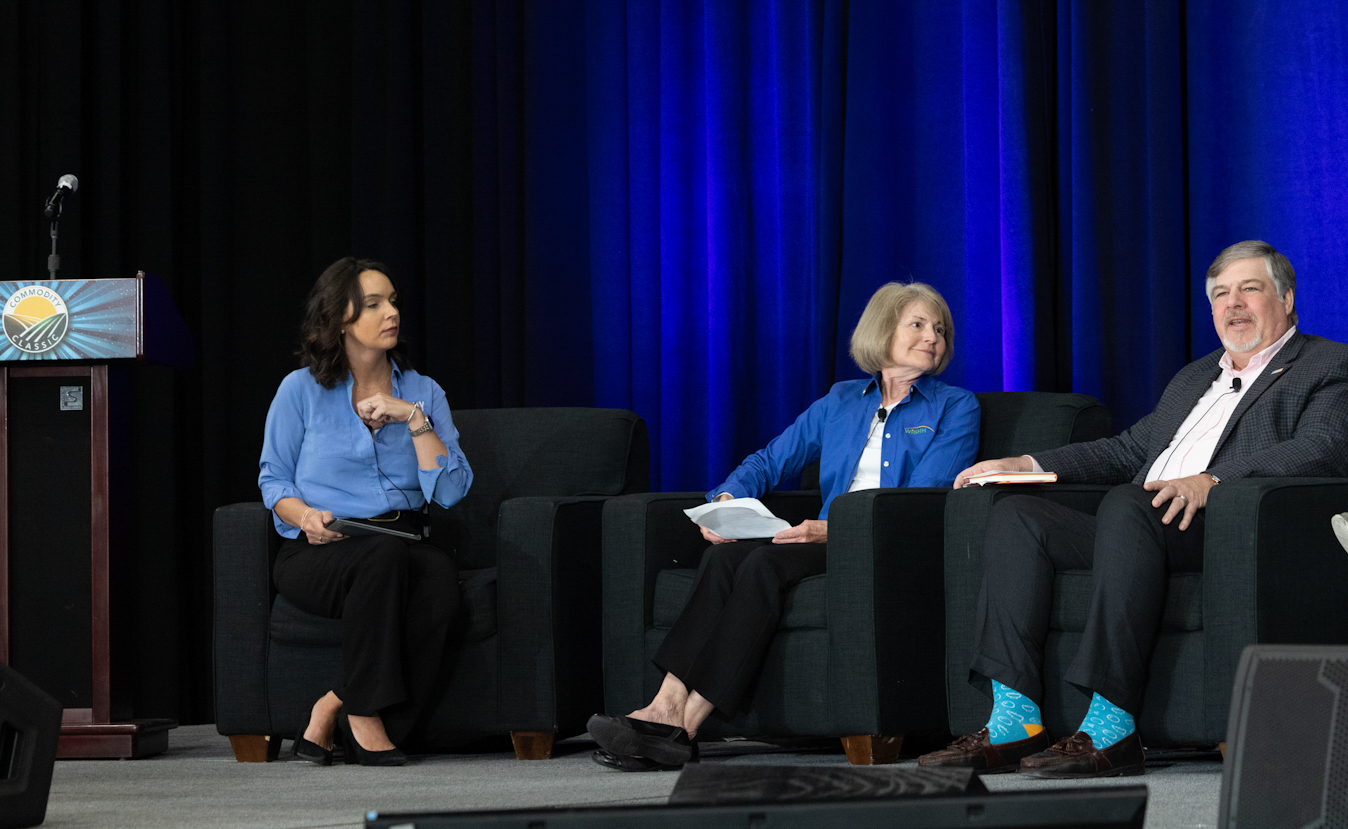
USSEC farmer-leaders addressed global food security and demonstrated close collaboration with other U.S. commodity export groups. Three board members participated in a panel discussion titled “Building New Markets to Meet the Challenge of Feeding the World” on February 29 at the 2024 Commodity Classic in Houston.
Stan Born, the immediate past chair of USSEC and a farmer from Lovington, Illinois, explained how USSEC helps customers take full advantage of the benefits of U.S. Soy, aligning with the U.N. sustainable development goal of achieving zero hunger.
“As I met with customers around the world during the past year, I saw first-hand how USSEC educates, equips and enables them to use U.S. Soy for food, feed and other uses,” he said. “We educate by sharing knowledge with business leaders. We equip with tools to understand and extract the value of U.S. Soy, and we enable them to access it by addressing market barriers.”
He also shared how the Soy Excellence Centers support early and mid-career protein professionals with industry-focused training.
“Globally, consumers want choice — the ability to choose food for their family,” Born explained.
He said that with the U.S. Sustainable Soybean Assurance Protocol, or SSAP, USSEC verifies that U.S. Soy is produced sustainably. During the last year, 70% of U.S. Soy exports carried that verification, including 40% of shipments to China.
“We’re seeing demand for sustainability show up in uncanny places,” he added. “For example, just a few weeks ago I attended a signing ceremony in Sri Lanka where two more customers agreed to use our ‘Fed with Sustainable U.S. Soy’ label on their products.”
Born stressed that he had volunteered time to address global food security through USSEC because no child should go hungry.
“Every kid deserves a chance, and nutrition is foundational to that,” he said. “Ensuring children can eat leads to national security.”
Fellow panelist Roberta Simpson-Dolbeare, who farms near Nebo, Illinois, has seen the need for better nutrition in developing countries. She serves as the chair of the World Initiative for Soy in Human Health, or WISHH, and she is a new member of the USSEC board.
WISHH works to improve global feed security by providing U.S. Soy as a protein solution in new, emerging markets. These projects help stabilize a new market so they can grow into export markets.
“I saw the importance of U.S. Soy’s protein in Ghana, where poultry producers recognized first-hand the benefits of feed for their birds that includes U.S. Soy,” she said. “WISHH worked with a food and feed manufacturer to sell soy protein products to the U.N. World Food Programme in that country.”
Simpson-Dolbeare also highlighted the rapid growth of aquaculture production in Sub-Saharan Africa, where WISHH trains young industry leaders in Ghana and Nigeria.
“Aquaculture is growing twice as fast there compared to the rest of the world,” she explained. “Wild-caught stocks are declining, but we know U.S. Soy protein makes a great fish feed. We are working to build the regional aquaculture industry for long-term trade and to meet food security needs for protein.”
She says customers want to know they will have a continual supply of protein to make possible these productivity improvements in poultry production, aquaculture and more.
The panel also included farmers representing the U.S. Grains Council (USGC), the U.S. Meat Export Federation (USMEF) and the U.S.A. Poultry and Egg Export Council (USAPEEC). USSEC works closely with each of these organizations in a variety of new and growing markets.
The USAPEEC representative on the panel, Claremont, South Dakota farmer Mike McCranie, exemplified this collaboration. McCranie has worked closely with USAPEEC, and he just started his second term as a USSEC director. He sees his voluntary commitment to global markets as one way to improve the industry for his sons, who farm with him, and their families.
McCranie noted how exporting protein in the form of meat, poultry and eggs both addresses global food security and the energy transition to higher volumes of bio-based fuels.
“Meat is a great way to export soybean meal,” he said. “At the same time, global customers are asking for sustainable products, and U.S. agriculture can deliver.”
The panelists noted that the sustainability of U.S. crop production supports the sustainability of meat and poultry exports.
McCranie shared that he has seen attitudes toward sustainability shifting for global consumers. For example, a few years ago he hosted buyers from a major food and feed company in Thailand on his farm, highlighting sustainable practices and giving them rides in his combine.
“The following year, the same buyers were in a meeting I attended in Thailand, where company leadership asked for help importing sustainable products, because that’s what their customers were asking for,” he shared. “We assured the leadership we could help, and I attended a Memorandum of Understanding signing a few months later in the U.S.”
Together, Born, Simpson-Dolbeare and McCranie demonstrated the leadership of U.S. Soy farmers in sustainability, valuable exports and industry collaboration.
This story was partially funded by U.S. Soy farmers, their checkoff and the soy value chain.
# # #